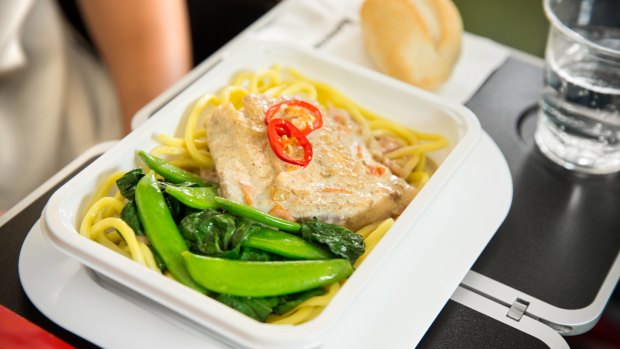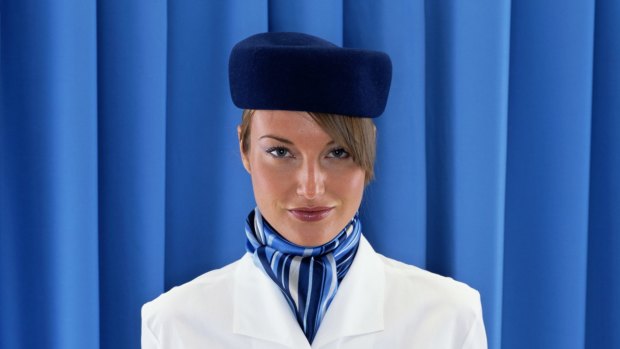This was published 9 years ago
Airline food: Chefs striving to improve mile high meals
By Sally Webb

Qantas's economy meal: Barramundi poached in a spiced coconut sauce with noodles, sugar snaps, choy sum and chilli.
It was Wolfgang Puck who famously claimed "an airplane is a good place to diet". The Austrian-born, US-based celebrity chef went on to become a pivotal part of American Airlines first "Chefs' Conclave" in the late 1980s, a team of culinary high-flyers charged with sorting out the airline's gastronomy in the sky.
Now it seems any airline worth its salt has a celebrity chef or two designing menus, in the pointy end at least (see below). However, the question remains: has it really made any difference to the quality of what is served at 10,000 metres?
Google "worst airline food" and you'll get more than 1.7 million results, with no shortage of travellers willing to share pictures of their hideous-looking meals. So, are airlines fighting a losing battle, particularly in economy, to serve good food in the air?
Not surprisingly, the answer, according to the airlines, is no. "Over the years, we have learned so much about the best food to prepare and serve on board, and it is continually improving," says Brendan Duffy, Cathay Pacific's catering manager, planning and concept design. "We never rest on our laurels when it comes to delivering a great inflight experience – it's about the comfort of our seats, the quality of our inflight entertainment, incredible inflight service from our award-winning cabin crew – but also of course, about offering the best possible inflight dining and drinks selection."
Recently Qantas unveiled a new and expanded economy meal service being rolled out on international long-haul flights as well as some domestic routes. Heralded as "redefining the travel experience", passengers will enjoy a wider choice of meals and 50 per cent larger servings.
Gone are the nasty plastic trays, replaced by single meals served more elegantly (as well as significantly more quickly) on underplates, with the usual two options increased to three in the aircraft and a fourth that can be pre-ordered online.

Sky food: What will all those plastic trays reveal?
The sample menu, which varies according to the route, offers smoky barbecue beef with roasted sweet potatoes and corn; or yellow curry of barramundi with green beans and rice. Bread rolls are replaced by garlic bread and snacks available during the flight include Weis ice-cream bars. It is a step closer to Qantas's consistently well-reviewed meal service in premium economy, business and first under Neil Perry and his Rockpool Group.
Singapore Airlines has long had a reputation for providing some of the better food in the skies, aided by its International Culinary Panel (ICP) of high-profile global chefs, including Australia's Matt Moran, who are consulted on menus in all classes (albeit with a stronger focus on premium passengers), with the aim to provide "hearty, wholesome" food that reflects the regions from which the airline flies.
An embattled Malaysia Airlines recently announced a partnership with popular television cook and former MasterChef contestant, Malaysian-born Poh Ling Yeow. For three monthsfrom the beginning of December her Nyonya chicken curry is a feature of in-flight menus between Australia and Kuala Lumpur and will also be served on flights between New Zealand and KL from January 1. The airline has also announced an innovative MH Gourmet option where for an extra $17 and 24 hours' notice passengers can upgrade their complimentary meal to dishes such as beef rendang tok, chicken cordon bleu or Poh's Nyonya curry.
Thanks to social media and peer review forums, it's easy for any potential airline customer to check out how airlines are travelling in the airfare stakes, and whether they are meeting expectations in the various classes.
Simon Westcott is the Hong Kong-based CEO of Luxe City Guides, and flies regularly in all classes on a variety of airlines. Expectations have increased, he says, particularly among Australian travellers. "We are a nation of masterchefs and spoilt by some of the best affordable (and expensive) dining out on the planet. Plus we spend way longer in planes than many of our other first-world friends. It's the perfect storm."
Westcott's expectations depend on where in the aircraft he's sitting. "Truly great food in economy, for me, is about comfort dishes with strong tastes and a light finish," he says. "Further up the plane, I want top produce (which shines in even the most basic kitchens or less expert hands) and excellent wines. I don't think either of these things are too hard to execute well in the air."
Cathay Pacific doesn't have a permanent chef stamping his or her cuisine and personality on the onboard menus, preferring their in-house chefs to collaborate periodically with existing restaurants in Hong Kong and further afield.
In 2013, the airline looked at how menus had changed in the past 50 years. Meals from the 1960s focused on the emerging fad of French fare - foie gras served with melba toast, and classic beef bourguignon. In the 1970s the influence of nouvelle cuisine, carefully plated food in small portions, was evident. By the 1990s the focus was Italian.
More recently the move is towards healthier dishes, as well as requests for special meals which reflect changing dietary habits. In 2012 alone there was a 216 per cent increase in demand for fruit platters; and requests for gluten-free dishes have risen114 per cent since 2008.
Airlines are also recognising that not everyone wants to eat a full meal every time they fly. Virgin Australia's meal provision varies according to which class you're in, how much you paid for your ticket, whether you're travelling domestically or internationally (and whether that's short or long-haul). A notable addition to the Luke Mangan-designed menus in business class is The Pantry, launched on flights on December 3, where passengers can select from lighter snacks such as sushi, finger sandwiches and olives.
Many airlines are also turning their attention to improving food offerings in lounges before the flight, for premium passengers and high-level economy frequent flyers at least. Qantas has new or upgraded lounges in Singapore, Hong Kong and Los Angeles, each with expansive Neil Perry-designed menus. In Hong Kong Cathay Pacific's first and business-class passengers are tucking into Dan Dan noodles and dumplings at the airline lounge's Noodle Bar.
Just how influential is the food in the customer's purchasing decision? "I don't believe food ranks higher than cost, comfort, or route in the majority of purchase decisions," Simon Westcott says. "I haven't seen any surveys that suggest otherwise, though I'd be interested to. My hunch is that food might be part of the ineffable feel-good factor that keeps some people loyal to certain brands, or, for long haul, if the experience is truly woeful, might be a repeat-booking deterrent, even if the ticket was cheap as chips."
Every airline seems to agree that providing decent food and continually improving it is an opportunity to encourage customer retention and create positive consumer engagement.
"The food in premium classes is rarely the first reason people choose to fly with a certain airline," says Qantas-Rockpool consultant Terry Higgins, "but it's often the reason they choose to return."
THE WHO'S WHO OF AIRLINE FOOD
SINGAPORE AIRLINES
WHO DESIGNS THE MENU: The International Culinary Panel of nine high-profile chefs includes Carlo Cracco from Milan, French chef Georges Blanc, Mumbai-based television chef Sanjeev Kapoor and Australia's Matt Moran, from Aria and Chiswick restaurants in Sydney.
TYPICAL DISHES: Beef rendang (economy); stir-fried prawns in garlic sauce, asparagus, capsicum, mushroom and ee fu noodles (business); beef fillet, braised brisket, mushroom ravioli, celeriac puree and braised shallots (first/suites).
QANTAS
WHO DESIGNS THE MENU: Award-winning Australian chef Neil Perry and his Rockpool Group Consultants.
TYPICAL DISHES: Barramundi poached in a spiced coconut sauce with noodles, sugar snaps, choy sum and chilli (economy); beef fillet with potato gratin, broccoli, mushroom and green peppercorn sauce (business); Patagonian toothfish with polenta (first).
VIRGIN AUSTRALIA
WHO DESIGNS THE MENU: Sydney-based celebrity chef and restaurateur Luke Mangan is responsible for Virgin's business class menu.
TYPICAL DISHES: Moroccan chicken with pearl cous cous (economy); barramundi fillet with bok choy (business).
QATAR AIRWAYS
WHO DESIGNS THE MENU: Four master chefs create the business and first menus: Nobu Matsuhisa, Tom Aikens, Ramzi Choueiri and Vineet Bhatia.
TYPICAL DISHES: Classic Arabic mezze with Arabic bread; Iranian mixed grill (both served in business and first).
AIR NEW ZEALAND
WHO DESIGNS THE MENU: New Zealander Peter Gordon of The Sugar Club and Bellota, Auckland and The Providores & Tapa Room and Kopapa, London.
TYPICAL DISHES: Kumara and pumpkin salad; tomato paprika beef with herb mash and peas (economy); poached hapuka with egg noodles, leeks and peas (premium economy).
JAL
WHO DESIGNS THE MENU: High-profile Japanese chefs – Seiji Yamammoto, Koji Shimomura, Fumiko Kono, Naoki Uchiyama, Hiroki Yoshitake, Shinichi Sato and Chikara Yamada – create both Japanese and Western dishes that are hands down winners for aesthetics in the sky.
TYPICAL DISHES: Udon de Sky instant noodles (premium economy); sukiyaki of wagyu beef fillet (first).
Sign up for the Traveller Deals newsletter
Get exclusive travel deals delivered straight to your inbox. Sign up now.